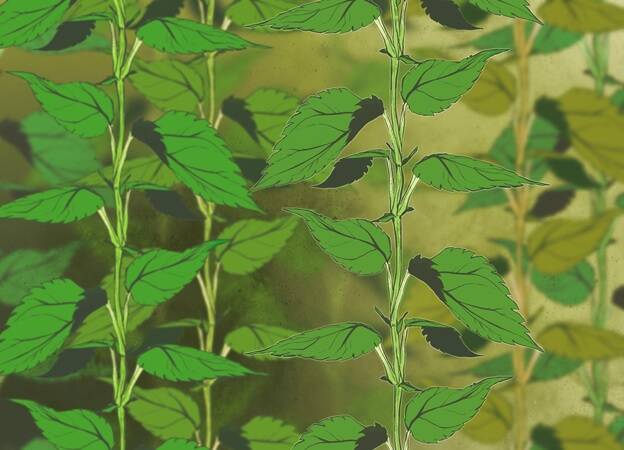Submitted by Sophie Citro, Kwiaht lab assistant and Lopez High School junior.
If you have visited any damp spots in the islands lately, you may have noticed conspicuous clusters of tall plants with serrated, heart-shaped leaves and clusters of small green, yellow or purple flowers. Stinging nettle (Urtica dioica) is a three-to-seven-foot tall perennial, native to the Pacific Northwest, and it is named for its painful “sting,” delivered by sharp hairs dotting its stem and both the tops and bottoms of its soft green leaves. Although it is often treated as a weed or pulled from yards to avoid accidental injury, nettle is actually surprisingly useful, both to humans and to the larger Salish Sea ecosystem.
Have you seen any vibrant orange butterflies lately? You have got nettles, host plants to a variety of butterfly species, to thank for that! Some nettle-dependent butterflies that might have stood out to you are the Satyr Comma (Polygonia satyrus), Red Admiral (Vanessa atalanta) and Milbert’s Tortoiseshell (Aglais milberti). All three spend the larval stages of their lives munching nettle leaves before hatching into beautiful adult orange-and-black butterflies in early- to mid-summer! Keeping nettles around is a surefire way to attract them to your garden. Moreover, while their stinging hairs may not bother caterpillars, deer generally avoid them.
If you intend to eat nettles yourself, they can easily be disarmed. Look for young, tender leaves for the best taste, then crush them or blanch them in boiling water to neutralize their stinging hairs. The leaves can be eaten raw for a strong spinach-like flavor or used to flavor salads. Blanched nettles make a strong-flavored pesto, and dried leaves make a delightful tea. Nettles can even be fried and salted to make nettle chips.
Nettles have other uses, too, beyond just food – they were also valued for centuries as a source of twine. The inner fibers of nettle stems were dried and wound into strong waterproof cordage that was used in fishing line and nets.
If you absolutely have to remove nettles from your garden or backyard, you needn’t let them go to waste. With a strong stick as a “nettle sword” and a large container of water, you can make your very own nettle fertilizer! Just plop slashed nettles into the container, making sure that there is enough water to cover them completely, and whack them until they are mushy. Place a lid on the container and wait for a week or two. The result smells terrible, but it is a nitrogen-rich fertilizer that, when diluted with water to about 10% of its original strength, is a free, environmentally friendly alternative to store-bought fertilizers. But be careful with how much you pour into your garden beds. Too much at one time can burn your plants’ leaves.
Aside from its material benefits to people, stinging nettle is an integral part of the Salish Sea ecosystem. The butterfly species that rely upon nettles as a larval host plant help provide food to other insects, as well as reptiles, shrews and other small mammals, bats and birds. Even the aphids that prey on the leaves are important, particularly to ladybugs. In the late fall, seed-eating birds such as siskins, finches and sparrows use the abundance of seeds to gain much-needed energy for the colder months ahead.
The next time you see nettles in your yard, think twice before pulling them!




